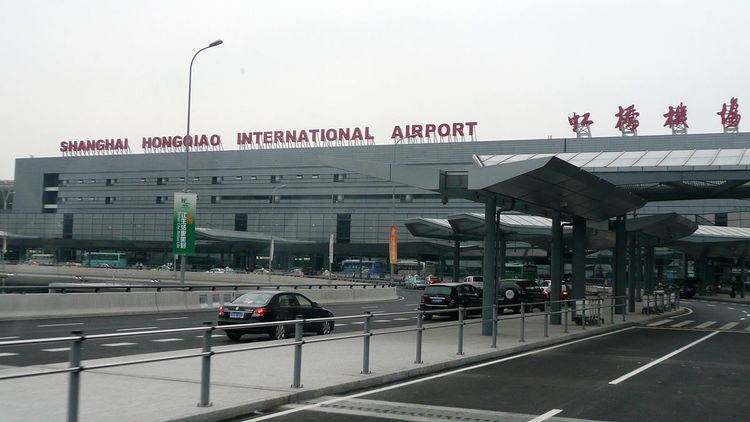Airport type Public Website Hongqiao Airport Elevation 3 m | Elevation AMSL 3 m / 10 ft Code SHA Phone +86 21 3253 1090 | |
 | ||
Operator Shanghai Airport Authority Location Changning–Minhang, Shanghai Address China, Shanghai Shi, Changning, 虹桥路2550号 邮政编码: 200335 | ||
Shanghai hongqiao international airport
Shanghai Hongqiao International Airport (IATA: SHA, ICAO: ZSSS) is one of two international airports of Shanghai and an important aviation hub of China. Hongqiao Airport mainly serves domestic and regional flights, with limited international flights. It is located near the town of Hongqiao in Changning District, 13 kilometres (8.1 mi) west of downtown, and is closer to the city center than Pudong Airport, Shanghai's main international airport.
Contents
- Shanghai hongqiao international airport
- Ride a skateboard shanghai hongqiao international airport
- History
- Other facilities
- Accidents and incidents
- Ground transportation
- References
Hongqiao Airport is a hub for China Eastern Airlines, Shanghai Airlines, Juneyao Airlines and Spring Airlines. In 2016, Hongqiao Airport handled 40,460,135 passengers, making it the 7th busiest airport in China and the 45th busiest in the world. By the end of 2011 Hongqiao Airport hosted 22 airlines serving 82 scheduled passenger destinations.
Ride a skateboard shanghai hongqiao international airport
History
An airport was first built in the town of Hongqiao in the west of Shanghai in 1907, initially as a small military airfield. In March 1923, it was upgraded into the Hongqiao Airport for mixed civilian use. In 1937, Hongqiao was the site of the so-called 'Oyama Incident' in which a Japanese lieutenant was shot dead by Chinese Peace Preservation Corps soldiers in the lead-up to the Battle of Shanghai. During the Second Sino-Japanese War, the airport was occupied by the Japanese and used as an air force base. Its military use continued after being handed over to the Republic of China government and, later, the People's Republic of China government. From late 1963, it was rebuilt for civilian use, and was re-opened in April 1964. A major expansion took place from March to September 1984, and another from December 1988 to December 1991.
Hongqiao Airport served as Shanghai's primary airport until the completion of Pudong International Airport in 1999, when almost all international flights were moved to Pudong. The airport presently offers mainly domestic flights, as well as five international or cross-border routes with "city-to-city" service to central Tokyo's Haneda Airport, central Seoul's Gimpo Airport, central Taipei's Songshan Airport, Hong Kong's Chek Lap Kok Airport, and Macau's Macau International Airport.
On 1 January 2013, holders of passports issued by 45 countries do not need a visa if transiting through Hongqiao Airport provided they hold valid passports.
In preparation for the Shanghai Expo, on 16 March 2010 Hongqiao Airport completed a five-year 15.3-billion-yuan expansion project, which included a 3,300-meter second runway and the new Terminal 2, boosting Hongqiao's capacity to 40 million passengers a year. Terminal 2 is four times the size of Terminal 1 and houses 90 percent of all airlines at the airport (Terminal 1 is now used only for international flights and Spring Airlines). With the new runway, Shanghai became the first city in China to have six runways for civilian use (Pudong and Hongqiao combined).
Other facilities
The airport has the head office of China Eastern Airlines, which is housed in the China Eastern Airlines Building, and the head office of China Cargo Airlines.
Accidents and incidents
Ground transportation
Terminal 2 of the Hongqiao Airport (31°11′46″N 121°19′18″E) is immediately adjacent to Shanghai Hongqiao Railway Station (31°11′46″N 121°18′58″E), a major train hub served by the Beijing–Shanghai High-Speed Railway, the Shanghai–Hangzhou High-Speed Railway and the Shanghai–Nanjing Intercity High-Speed Railway. The airport's other terminal, Terminal 1 (31°11′50″N 121°20′32″E), is across the airfield from Terminal 2.
The airport and the railway station are served by three stations of the metro network:
The proposed extension of the Shanghai Maglev Train from Longyang Road through Shanghai South Railway Station to Hongqiao would connect the two airports. At top speed, the maglev would take only 15 minutes to travel the 55 km route. Original plans called for completing the extension by 2010, in time for the 2010 Shanghai World Expo; however, the Hongqiao extension has been indefinitely postponed due to protests.
